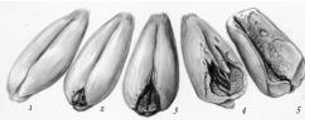Karnal bunt was first discovered or reported in India in 1931, in a city called Karnal of the State of Haryana, which is also where the disease gets its name from. The disease is caused by Tilletia indica, and it’s also referred to as partial bunt. It was established in Mexico in 1982 and is also found in the USA, Pakistan, Iraq and Afghanistan. This disease is sometimes mistaken for similar diseases like black point, common bunt, and dwarf bunt. In South Africa, KB was first reported in 2000 in the Douglas area of the Northern Cape where it was quarantined and subsequently controlled. It re-appeared in 2015 in the Groblersdal area of Limpopo.
The most susceptible host of the disease is bread wheat. Triticale and durum wheat are also susceptible but to a much lesser degree. Rye is a host, but is said to be infected only via artificial inoculation, showing some resistance. Barley and oats are not hosts of the pathogen.
Partial bunt gets its name from the fact that the fungus typically affects a portion of kernels per head and also few heads within a plant. The fungus produces a chemical called trimethylamine which makes the affected seed have a fishy smell. Seeds are dark, usually remain whole, sometimes with varying levels of erosion on the germ along the kernel groove. Kernels are susceptible for an extended period between Zadoks 43 and 69, resulting in the varying degrees of erosion. Affected areas have a black powdery spore mass within the endosperm near the embryo or along the groove.
 Figure 1: Varying levels of Karnel Bunt symptoms: 1. Healthy wheat seed. 2. “Tip” infection. 3. More advanced tip infection. 4. Advanced infection. 5. “canoe” symptom hollowing out interior of seed.
Figure 1: Varying levels of Karnel Bunt symptoms: 1. Healthy wheat seed. 2. “Tip” infection. 3. More advanced tip infection. 4. Advanced infection. 5. “canoe” symptom hollowing out interior of seed.
Yield losses to Karnal Bunt are usually not severe, it is considered a disease moderate economic importance in most countries it occurs. India reported losses of up to 40% where highly susceptible cultivars were grown, but countrywide yield loss was about 0.5% and in Mexico losses are at a maximum at 1%. The severe effect of the pathogen, which makes it an important disease, is the economic costs on exports as it is a quarantine pathogen in over 40 countries. Countries with KB infestations are known as “KB positive” countries and are under quarantine thereby putting the exports of these counties at risk. Wheat that contains more than 3% bunted kernels is considered unfit for human consumption and it results in bad odour and reduced palatability of both whole meal and finished products.
Ideal conditions for infection are cool temperatures (9-24oC soil, 15-22oC air) and high humidity (from rainfall or overhead irrigation) during the heading stage and for at least 48 hours afterwards for the pathogen to develop. The disease is difficult to detect on growing plants and can only be detected once the grain is removed from the head (sampled or during harvest) and examined. Teliospores are produced by the fungus and are carried in soil, farm implements, seed and other plant parts. The spores can also be windborne, lifted during field burning of wheat residues where they may remain viable. Infected seeds are the primary means of getting spores into the soil, where they remain as a source of inoculum for the following years. Spores remain viable in the soil for 5 to 7 years, surviving extreme conditions such as sunlight, dry conditions and temperatures of down to -5oC.
Karnal Bunt is very difficult to control when compared to the other related bunt/smut fungicide species. Chemical seed treatments that reduce teliospore germination of karnal bunt appear to be limited in how long they remain effective, and, with the possible exception of the mercurial compounds, none is capable of killing teliospores when applied to infected seed. The spores remain viable and will still germinate once the seed fungicide treatment has been washed off them because infection occurs at the heading stage, and at that point the chemical is insufficient. Foliar spraying with propiconazole, triadimefon and carbendazim can control the incidence of T. indica on wheat. The ARC suggested that initial foliar spraying should be conducted at 25% heading, and the second one 10 days later.
Late plantings under optimal conditions increase the occurrence of the disease. Farm implements should be cleaned with high pressure sprayers, limiting the spread of disease between farms.
Breeding for KB resistance at CIMMYT began in the early 1980s and from 1984 to 2001 a Karnal bunt screening nursery was distributed to numerous collaborators to introgress resistance in breeding programs. KB resistant material can be sent upon request from CIMMYT. Screening by inoculation is only done in a dedicated nursery at CIMMYT, Obregon, Mexico located in area where the disease is well established.
The best cultivars with resistance:
Bread wheat: Arivechi M92, HD 29, HD 30, Navojoa M2007, INIFAP M97;
Durum wheat: Altar C84, Jupare C2001, Aconchi C89, Atil C2000, Banamichi C2004.